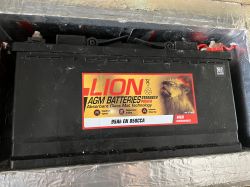FAQ
TL;DR: In 12V inverter runs, a 0.5V drop can trigger shut‑down; “What counts above all is the allowable voltage drop on the cable…”. Size cable by drop, keep leads short, and avoid one‑size amp/mm² rules. [Elektroda, teskot, post #20559626]
Why it matters: This helps 12V DIYers pick the right cable and battery so 1000W inverters don’t trip on low voltage or waste power.
Quick Facts
- 1000W at 12V draws ≈84A; with ~90% inverter efficiency, expect close to 100A input. [Elektroda, teskot, post #20558242]
- Round‑trip counts: 3 m one‑way = 6 m conductor; 25 mm² at 100A drops ~0.432V and wastes ~43W as heat. [Elektroda, teskot, post #20558242]
- Renogy guidance for its 1000W/12V model: use 25 mm² battery leads. [Elektroda, burczynski82, post #20559527]
- High load slashes usable capacity: a 100Ah AGM can last <30 minutes at ~1kW; ~500Ah is reasonable for sustained use. [Elektroda, teskot, post #20558279]
- Parallel packs: keep interconnects very short, or run individual equal cables from each battery to the inverter. [Elektroda, teskot, post #20558337]
What cable cross‑section do I need for a 12V 1000W inverter over ~3 m?
Plan for ~100A input. For a 3 m run (6 m round‑trip), 25 mm² copper drops ~0.432V and burns ~43W. That is acceptable for many builds, but 35 mm² reduces loss and heat. Use fine‑strand copper, tight lugs, and short runs. [Elektroda, teskot, post #20558242]
How do I calculate DC voltage drop for my inverter cables?
Use copper’s resistivity in a simple formula. 1) Double the one‑way length for round‑trip. 2) Compute drop: U = I × 0.018 × L / S (Ω·mm²/m). 3) Check U against your inverter’s low‑voltage cutoff margin. Example: 100A, 6 m, 25 mm² → 0.432V drop; heat ≈ 43W (P = I × U). [Elektroda, teskot, post #20558242]
Does the “1 mm² per 8 A” rule work for 12V systems?
No. That ignores voltage drop, which dominates at 12V. “What counts above all is the allowable voltage drop on the cable, regardless of the power dissipated on it.” Even a 0.5V drop can force premature inverter cutoff. Size by drop, not a current‑only rule. [Elektroda, teskot, post #20559626]
Will a single 95–100Ah AGM battery run a 1000W inverter well?
Not for long. At heavy load the usable capacity can be ≤50Ah, giving under 30 minutes runtime at ~1kW. Deep discharges also shorten life if not recharged promptly. For reasonable runtime at this power, plan around 500Ah of lead capacity. [Elektroda, teskot, post #20558279]
My battery says AGM/VRLA—Is that lithium?
No. AGM/VRLA is a sealed lead‑acid battery with electrolyte absorbed in a glass mat. It is not Li‑ion. Expect good cranking/buffer roles, but capacity at high discharge is limited versus lithium packs of similar Ah. [Elektroda, teskot, post #20558311]
Can I add another battery in parallel to improve performance? Any matching rules?
Yes. Parallel batteries should match type, capacity, and condition to avoid unequal sharing from different internal resistances. Check datasheets: many starter/buffer batteries quote capacity at 20‑hour rate (C20), while deep‑cycle types often specify 5‑hour rate (C5). [Elektroda, teskot, post #20558329]
How should I wire two batteries to the inverter to share current well?
Keep the interconnect between batteries very short. Better yet, run individual equal‑length positive and negative cables from each battery to the inverter’s terminals to balance voltage drop. Use identical lugs and crimp quality. [Elektroda, teskot, post #20558337]
What wire size did Renogy recommend for its 12V 1000W inverter?
The manufacturer advised using 25 mm² battery cables for this specific model. Follow device guidance first, then verify voltage‑drop is within your target at peak load and surge. [Elektroda, burczynski82, post #20559527]
What happens if my cables are too thin or too long?
You get excessive drop and heat, and the inverter may shut down early. Example edge case: with a 0.5V drop, a battery at 11.5V leaves only 11.0V at the inverter, triggering low‑voltage cut‑off and stranding usable capacity. [Elektroda, teskot, post #20559626]
Do I count the return path in cable length (is 3 m actually 6 m)?
Yes. Current leaves and returns, so resistance and drop are based on round‑trip length. A 3 m one‑way run is 6 m of conductor for voltage‑drop calculations and power loss. [Elektroda, teskot, post #20558242]
Is there a calculator I can use for short cable runs?
Yes. Try the KIS voltage‑drop calculator referenced in the discussion. It lets you enter short lengths, currents, and conductor data to estimate drop and heat, then adjust cable size. [Elektroda, modziul, post #20558425]
What input current should I design for at 1000W?
Compute steady draw as P/V. 1000W/12V ≈ 84A. Include inverter efficiency: at ~90% efficiency, input rises toward 93–100A. Size cables and fusing for this current and any surge requirements. [Elektroda, teskot, post #20558242]



